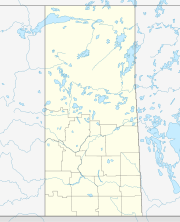Waldheim, Saskatchewan
| Waldheim | |
|---|---|

Central Avenue and Main Street
|
|
|
Nickname(s): Home in the woods The 'Heim |
|
| Town of Waldheim in Saskatchewan | |
| Coordinates: 52°39′N 106°37′W / 52.650°N 106.617°WCoordinates: 52°39′N 106°37′W / 52.650°N 106.617°W | |
| Country | Canada |
| Provinces and territories of Canada | Saskatchewan |
| Rural Municipalities (R.M.) | Laird No. 404 |
| Hamlet and Post office Founded in the NWT | 1900-06-01 |
| Village | 1908 |
| Town | 1967 |
| Government | |
| • Federal Electoral District | Carlton Trail-Eagle Creek |
| • M.P. | Kelly Block |
| • Provincial Constituency | Biggar-Sask Valley |
| • M.L.A. | Randy Weekes |
| Area | |
| • Total | 1.97 km2 (0.76 sq mi) |
| Population (2011) | |
| • Total | 1,035 |
| • Density | 525.5/km2 (1,361/sq mi) |
| Time zone | CST (UTC−6) |
| Website | waldheim |
Nickname(s): Home in the woods
Waldheim is a town of 1,035 residents in the rural municipality of Laird No. 404, in the Canadian province of Saskatchewan, located 57 km north of Saskatoon. Waldheim is located on Highway 312 in central Saskatchewan, the "Heart of the Old Northwest". Fort Carlton, , Battle of Fish Creek, and Seager Wheeler's Maple Grove Farm are all near Waldheim.
Mennonites from Manitoba and South Dakota arrived here to settle and farm in 1893. The Canadian Northern Railway arrived in 1908.
Particularly in the 1870s, Mennonites of Dutch-German origins residing in colonies in the Black Sea region of present-day Ukraine became alarmed at the rising nationalism in the Russian Empire. Along with land shortages in these growing colonies, pressure toward Russification of minorities was threatening Mennonite values in education. Similarly, the promise made by Catherine the Great to exempt them from military service was quite clearly being challenged and rewritten by the then current Russian government. Canada was seeking farming immigrants, and about 7,000 Mennonites chose to immigrate to Manitoba where the government of Canada set aside two reserves for their resettlement. In the early 1890s, some of these families decided to move on to District of Saskatchewan, thereby establishing a trend that would see considerable Mennonite immigration to the Saskatchewan Valley area before the turn of the century. Many came from Manitoba, but others arrived directly from colonies in Russia, from the Danzig region of Prussia and from Kansas, Nebraska and Minnesota where they had settled in the 1870s.
...
Wikipedia

